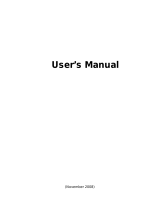
Windows Keys ...................................................................2-7
Function Keys ....................................................................2-8
Fn Key................................................................................2-8
Hot Keys ............................................................................2-8
Using the Touchpad ...............................................................2-10
Configuring the Touchpad ...............................................2-12
Using the Floppy Disk Drive .................................................2-13
Connecting the Floppy Disk Drive ..................................2-13
Inserting and Ejecting Floppy Disks ................................2-14
Using the Hard Disk Drive ....................................................2-15
Using the DVD Drive ............................................................2-16
Inserting and Removing a CD..........................................2-17
Using the Video Features.......................................................2-18
Configuring the Display Modes .......................................2-18
Using the Audio Features ......................................................2-19
Connecting Audio Devices ..............................................2-20
Using the Communication Features.......................................2-21
Using the Modem.............................................................2-21
Using the LAN .................................................................2-22
Using the Wireless LAN ..................................................2-23
Chapter 3 Managing Power....................................................3-1
AC Adapter..............................................................................3-2
Battery Pack.............................................................................3-3
Charging the Battery Pack .................................................3-3
Initializing the Battery Pack...............................................3-4
Checking the Battery Level................................................3-4
Replacing the Battery Pack ................................................3-4
Battery Low Signals and Actions.......................................3-6
Power Management .................................................................3-7
Hibernation.........................................................................3-8
Power-Saving Tips...................................................................3-9
Chapter 4 Expanding Your Computer...................................4-1
Connecting an External Monitor..............................................4-2
ii




















